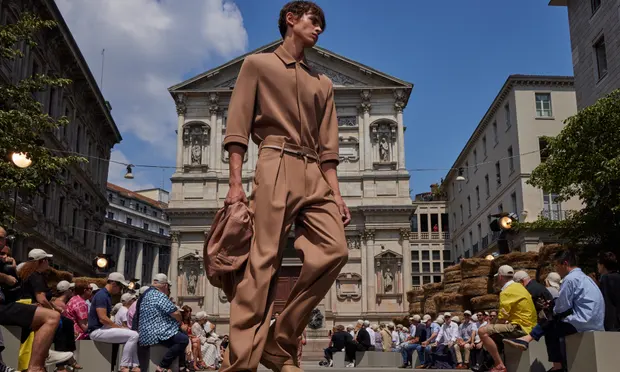Menswear has moved away from logos to more refined silhouettes, with collections from Prada to Valentino ditching streetwear
Such is the piercing influence of Succession on the wardrobes of the rich and famous that its stars didn’t even need to make a front-row appearance at Milan fashion week to make their presence felt. Excess is out and elegance is in as designers pursue the “quiet luxury” look that owes much of its recent popularity to the Roy family stone.
At Prada, the bellwether of where the fashion mood heads next, the co-designers Miuccia Prada and Raf Simons used the humble white shirt as a springboard for “a reconsideration of simple things”, said Prada after the show on Sunday.
“We were aiming to have quite a refined silhouette as we know it in men’s fashion – a 40s kind of construction that deals very much with the idealisation of the male body,” said Simons.
At Valentino on Friday, the designer Pierpaolo Piccioli presented a collection of languid separates that addressed “the reality of masculinity now”. For the second season in a row, Dolce & Gabbana ditched the distressed denim and diamanté suits in favour of tailoring and “the well-cut garment” on Saturday afternoon. Even the front rows of the four-day showcase, which ended on Monday afternoon, were unusually quiet on the celebrity front, further emphasising the new low-key mood.
With the logo-mania and high-profile collaborations of recent years left in the dust, brands have been finding new ways to make sartorial stealth stand out.
“This trend is still the strongest message coming from Milan, however, it is now slightly more elaborate in detailing once you look closer at the garments and silhouettes,” said Ida Petersson, buying director at Browns.
“We are already seeing men move away from logos to a more refined way of dressing, however it’s also clear that the gorpcore, more technical way of dressing remain as a strong sales driver and we’re excited to see how customers responds to the evolution of this trend and the brands that are able to marry those traditional performance wear styles with relaxed tailoring.”
For much of the Italian contingent on the schedule, the return of understated luxury is welcome news. Brunello Cucinelli, Zegna, Tod’s, Giorgio Armani and Brioni all presented collections that eschewed the streetwear influences that had crept in of late. At the latter, the creative director, Norbert Stumpfl pointed to blazers that take months just for the fabric alone to be made.
Despite its moniker, quiet luxury is designed to speak volumes. These are still clothes that can cost more than the average monthly payslip and they need to look it.
“It’s about extreme material integrity, and tailoring skills developed by true experts and products at a price point way above even mainstream luxury,” said Lucie Greene, trend forecaster and founder of consultancy Light Years.
Style, with substance: what’s really trending this week, a roundup of the best fashion journalism and your wardrobe dilemmas solved
“It’s about the cashmere sweater that is just the right colour, with subtle detail, light-as-a-feather softness that no one except the wearer – or a stealth observer – would know and that costs several thousand pounds. It’s the opposite of someone wearing a designer logo belt, or handbag.”
As well as Succession’s influence, the roots of quiet fashion are linked to the consolidation of wealth in recent years, particularly during the pandemic where more money than ever has concentrated at the very top, says Greene. “This has seen a drive for ultra-high net worth groups to differentiate themselves from commodified obvious luxury by embracing quietness, discretion, privacy, and institutional wealth codes even more – the more if-you-know-you-know the better.”
It sets the scene, she continues, for brands to come up with ever more exclusive, but subtle ways to communicate wealth and takes care of unwanted optics.
“Part of it is tactical. In this climate of extreme inequality, being obviously outrageously wealthy has become distasteful and contentious in wider society, see the flood of ‘eat-the-rich’ narratives from The White Lotus to Triangle of Sadness.”
Source: The Guardian



Recent Comments